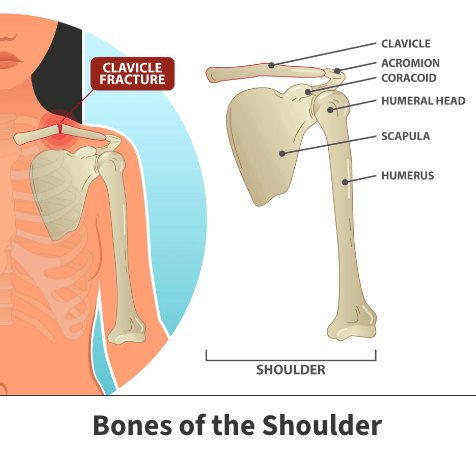Clavicle fractures
Your upper body plays a major role in your physical abilities. Body parts located in or near your shoulders, upper back, and neck play a key role in helping you perform activities like raising your arms, lifting various items, and participating in many sports.
One such part is the clavicle, which is more commonly known as the collarbone.
Clavicle fractures are relatively common injuries, with the clavicle being the most commonly broken bone in the human body. 5% of all adult fractures and 13% of children’s fractures are clavicle fractures. They are roughly 5% of all fractures seen in hospital emergency rooms and occur more often in males.
Anatomy

The collarbone is located in the upper shoulder region. It is situated between the shoulder blade (the scapula) and the rib cage (the sternum).
About
Clavicle fractures happen when the collarbone sustains some type of breakage. Such damages can occur in any area of the bone. Fractures are usually seen in the middle area. A small percentage of clavicle fractures happen near the place where the bone and rib cage meet.
Clavicle fractures can occur in different forms. In the least severe cases, the bone only breaks slightly and does not sustain any significant damage.
More severe incidents might result in the shattering of the bone into tiny fragments. In medical terms, such events are called comminuted fractures.
The most significant occurrence takes place when the breakage shifts the bone out of its natural position. These are called displaced fractures.
Causes
Typically, clavicle fractures are the direct result of traumatic and forceful contact with the shoulder region. Examples are the physical hits you might receive in intense athletic competition or from an event like a car accident or a significant fall.
Risk factors
Your risk of sustaining clavicle fractures significantly increases if you participate in physical sports like football or wrestling.
Symptoms
The most obvious sign of a clavicle fracture is pain. This discomfort can be intense and worsen when you attempt to move the affected arm. Additionally, you might encounter:
- Difficulties lifting or even moving the injured shoulder
- A grinding sound when you lift the stricken arm or shoulder
- The development of a bump or lump immediately over where the breakage occurred
- The appearance of bruising, redness, and swelling over the injured collarbone
The most severe cases could force your injured shoulder to sag forward and downward, which can make standing, walking, and carrying out routine activities challenging.
Complications
If not treated quickly, fractures could worsen or spread to other parts of the bone. Without receiving adequate medical care bone fractures may fail to heal correctly.
Occasionally, broken bone pieces can move out of place and heal in awkward positions. In scientific terms, such events are called malunions. These occurrences could eventually limit your ability to move your arm and shoulder, cause noticeable deformities, and lead to lasting pain.

Diagnosis
Your doctor will usually confirm a diagnosis after performing several steps.
During the examination’s your doctor will perform several visual observations. Clavicle fractures often have certain telltale signs that trained healthcare providers can spot in relatively short order.
Though rare, more severe breaks can damage surrounding nerves and blood vessels. Your physician will check to make sure these vital structures are safe and intact.
Should visual clues not provide enough information for your doctor to offer a firm diagnosis, you might be asked to undergo internal imaging tests. The pictures produced by diagnostic tools, such as CT scans (computerized tomography) or X-rays, enable your doctor to view images of your collarbone and readily see damages like bone fractures.
Treatment
Several factors will play into the specific treatment you will need, including:
- Your age
- The fracture’s severity
- The type of fracture you sustained
- Your level of physical fitness
Fortunately, not all injuries need surgery.
Nonsurgical treatments
Minor breaks (and those that have not resulted in bone displacement) can be treated using nonsurgically. Treatments include supporting the injured shoulder, physical therapy, and medications.
Uncomplicated fractures are often treated by placing the injured shoulder inside a supportive device like a sling. Such efforts ensure the damaged bone cannot shift. Movement could delay the healing process or worsen the existing injury.
As the healing process progresses, you will likely be required to undergo physical therapy. PT, as it is often abbreviated, is an individualized set of exercises designed to help your shoulder regain the strength and mobility it may have lost while injured.
Over-the-counter pain-relievers and inflammation-reducers might lessen the associated discomfort and swelling. If the pain is bad enough, your doctor might prescribe prescription painkillers.
Surgical treatments
Severe fractures involving dislocation may need surgery.
The most performed surgical procedures used for clavicle fractures places the broken bones back into their original positions. This process is called open reduction and internal fixation. The surgery is performed in two stages.
During the first phase, surgeons reposition shattered bone pieces into their normal position. This part of the surgery is called reduction.
Once reduction is completed, the bones are held in place using combinations of metal items like plates and screws or pins and screws. This attachment stage is known as internal fixation.
Following surgery, you should expect to undergo a course of physical therapy.
Outlook
In many instances, promptly treated and uncomplicated clavicle fractures heal within a couple of months. If you are physically active, you may expect to return to full participation in about three months.
But the process could need more healing time. You will need follow-up examinations to measure how well the healing process is progressing. You should not place any undue strain on the affected shoulder until your doctor or surgeon determines such activities are safe.
Videos
Related specialties
- AC Joint Injuries
- Atraumatic Shoulder Instability
- Bankart Repair
- Bicep Tenodesis
- Broken Collarbone
- Bursitis of the Shoulder (Subacromial Bursitis)
- Calcific Tendinitis of the Shoulder
- Dislocated Shoulder
- Fractures of the Shoulder Blade (Scapula)
- Glenoid Labrum Tear
- Impingement Syndrome of the Shoulder
- Little League Shoulder
- Reverse Total Shoulder Replacement
- Rheumatoid Arthritis (RA) of the Shoulder
- Rotator Cuff Tears
- Shoulder Arthritis
- Shoulder Arthroscopy
- Shoulder Injury: Pain in the Overhead Athlete
- Shoulder Replacement
- Shoulder Separations
- Shoulder Socket Fracture (Glenoid Fracture)
- SLAP Tears & Repairs
- Subacromial Decompression
- Trapezius Strain (Muscle Strain Of The Upper Back)
- Traumatic Shoulder Instability
